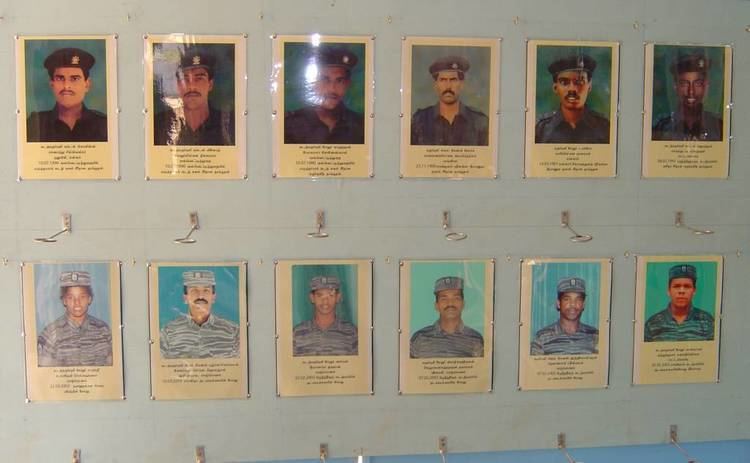 | ||
The Black Tigers (Tamil: கரும்புலிகள்) were a wing of the Liberation Tigers of Tamil Eelam (LTTE), a militant Sri Lankan Tamil separatist organisation. They were specially selected and trained LTTE cadres whose missions included mounting suicide attacks against military and civilian targets. Civilian targets included places of worship, ports, airports and assassinations of high-profile Indian and Sri Lankan dignitaries, among them Sri Lankan President Ranasinghe Premadasa. From their formation in 1987 until the defeat of the Tamil Tigers in 2009, more than 330 Black Tigers made suicide attacks on land and sea, mostly in Sri Lanka.
Contents
History
The first Black Tiger was Vallipuram Vasanthan, who drove a small truck laden with explosives into a Sri Lanka Army (SLA) camp in Nelliady, Jaffna peninsula, on 5 July 1987, killing himself and between 39 and 100 Sri Lankan soldiers. Immediately afterwards, regular LTTE cadres followed up, overwhelming the stunned SLA soldiers. This attack was hugely effective, and proved vital in the dismantling the Sri Lanka Army’s Operation Liberation.
During the earlier phase of the Tamil Tigers’ military campaign, it did not possess the heavy conventional weapons required to attack large camps. To mount such an attack, costly weapons such as artillery pieces, missiles, and fighter-bombers would have been needed – weapons that the LTTE could not afford to purchase. As a result, they decided to resort to asymmetric warfare, creating a special wing to make up for their inadequate weaponry. Consequently, it is not the act itself—killing by suicide—that was the Black Tigers' original or even main aim, but rather the military impact and its strategic consequences.
After 18 May 2009, following the death of LTTE leader Velupillai Prabhakaran, the Black Tigers ceased to exist, along with other LTTE fighting formations.
Notable attacks
In May 1991, a woman Tiger who had allegedly been raped by Indian Peace Keeping Force soldiers blew herself up, killing former Indian Prime Minister Rajiv Gandhi, along with 16 bystanders. On 1 May 1993, another Black Tiger assassinated Sri Lankan President Ranasinghe Premadasa and 23 others during a May Day parade. In July 2001, 14 Black Tigers attacked Bandaranaike International Airport, causing an estimated of $350 million USD worth of damage, mainly to military and civilian aircraft.
Recruitment
Black Tigers were drawn from the ranks of the LTTE. Those who wanted to join wrote letters to Velupillai Prabhakaran, the founder and leader of the LTTE. According to the LTTE, Prabakaran evaluated the applications, examining the applicant's particular skills, the kinds of missions he or she had been involved in, their motivations and their family situations. All these factors were considered in deciding whether he or she could become a Black Tiger.
Modus operandi
Up to the defeat of LTTE, the Black Tigers carried out 100 to 200 missions. The Black Tigers operated in three distinct ways: conventional combat on land and at sea, guerrilla attacks, and assassinations or bombings. The majority of these attacks involved military objectives in the north and east of the country. Relatively speaking, there were fewer operations in the south, where most of the Sinhalese live, especially in the capital city, Colombo, although such attacks often engaged high-profile targets and attracted much international publicity as a result. The last such attack was on government politicians during a Muslim festival.
